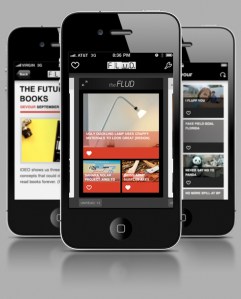 News aggregators and RSS feeds have been around for awhile now, but only with the rapid proliferation of touch technology on mobile devices and tablets, have we started moving closer to a truly appealing news feed experience.
News aggregators and RSS feeds have been around for awhile now, but only with the rapid proliferation of touch technology on mobile devices and tablets, have we started moving closer to a truly appealing news feed experience.
For the average web user, the traditional staid design and text-and-headline-heavy interface of the RSS feed and feed aggregators have offered user experiences to be endured rather than enjoyed.
News apps for both the iPhone and iPad, like Pulse and Flipboard, have garnered quite a bit of attention of late for disrupting the aggregation and RSS reader experience by offering up new, intriguing ways of representing data. With interactive and clever designs that leave templates open enough to allow users to fill them with their own feeds and customized content, the publishing industry seems exciting again.
The success of these apps is largely due to the fact that developers are learning that a good news reader relies, first and foremost, on design. It may make us feel a bit superficial, but it’s true, with a seemingly never-ending supply of news, for aggregators and readers, it’s all about image. Give me an aesthetically-pleasing news filter that sloughs off that long list of text and headlines in favor of an organic and interactive interface, and I’ll show you an active (and happy) user.
But when it comes to news consumption, I’d rather look to feeds emanating from editorially directed and curated magazines and websites, rather than a template populated by Facebook and Twitter such as Flipboard—or a design and user experience that is a bit sexier than Pulse—and I’d love to have quality versions on my iPhone (that have true staying power). This is why I’ve recently become a fan of FLUD, which allows users to plug in feeds from favorite sites (like TechCrunch, ahem) and read, peruse, and share articles through a neatly-presented, tile-based interface—for free. And unlike Flipboad, FLUD is on both the iPad and iPhone—and it’s coming soon to Android and the desktop.
 What’s great about FLUD is that it initially offers 25 FLUD-curated feeds to choose from, but the options are unlimited. You can add as many feeds as you’d like, filling FLUD’s template—which dominates sites’ specific CSS in a unifying, pretty design—through its list of featured feeds or by a simple keyword search, and a page is automatically created and filled with news from your chosen site. On your iPhone, each feed fits neatly on screen, which highlights each site’s content (something that’s likely pretty appealing to publications). FLUD also employs a scrubber that calls up a scroll bar, allowing you to quickly swipe past other stories. This puts the UX slightly above Pulse in eliminating that overwhelming mish-mash of feeds on a single screen.
What’s great about FLUD is that it initially offers 25 FLUD-curated feeds to choose from, but the options are unlimited. You can add as many feeds as you’d like, filling FLUD’s template—which dominates sites’ specific CSS in a unifying, pretty design—through its list of featured feeds or by a simple keyword search, and a page is automatically created and filled with news from your chosen site. On your iPhone, each feed fits neatly on screen, which highlights each site’s content (something that’s likely pretty appealing to publications). FLUD also employs a scrubber that calls up a scroll bar, allowing you to quickly swipe past other stories. This puts the UX slightly above Pulse in eliminating that overwhelming mish-mash of feeds on a single screen.
Tapping on the boxes, which can be scrolled through vertically or horizontally, brings the summary of the story into view, whereupon you can choose to view the basic text, switch to the web page, read it in your browser, or read offline. You can “love” particular stories, influencing items that other FLUD readers who use the same feeds will see and share your favorite links via Facebook and Twitter.
With Flipboard recently being named the 2010 iPad app of the year by Apple, and as apps like Pulse continue to hold ground high in the App Store rankings, FLUD has some serious competition in the marketplace—adding to the pressure to incorporate social media feeds as actual sources of news, rather than simply means for sharing. Yet, as FLUD remains a boot-strapped enterprise at this point, the company has some ground to cover on apps like Flipboard, which already has $10.5 million in funding.
Though FLUD Founder & CEO Bobby Ghoshal says that the app has been adding a new user every 4 seconds in December, drawbacks remain. I’ve experienced a lack of compatibility with older iPhones (3GS and earlier) and some serious delays in loading as you move content around; these lags and glitches manifesting themselves in the daily FLUD experience will need to be fixed if the company expects to build on its early success.
As to how FLUD hopes to become profitable in 2011—a question many free news and media-oriented apps must answer—Ghoshal says that FLUD is intent on staying away from ads as a primary source of revenue, hoping to encourage potentially different models, like revenue sharing built through partnerships with publishers and local businesses in an effort to incentivize users to buy locally. That sounds like a stretch—a news aggregator subsisting on anything other than ads may be a pipe dream—but who knows?
Nonetheless, if it figures out its revenue model revenue models, FLUD may be establishing itself as a force to be reckoned with in the news feed arena. Next up: the addition of a rating system (like the one available in iTunes), and an increased focus on social media feeds.